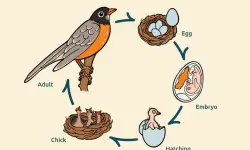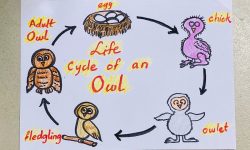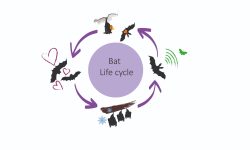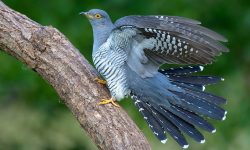Swallows are among the most iconic aerial acrobats of the bird world, known for their graceful flight and long migratory journeys. But before they become masters of the sky, swallows undergo a fascinating transformation—from fragile eggs to skilled fliers. This article explores each stage of the swallow’s life cycle in detail, revealing the biological intricacies behind their development, behavior, and survival.
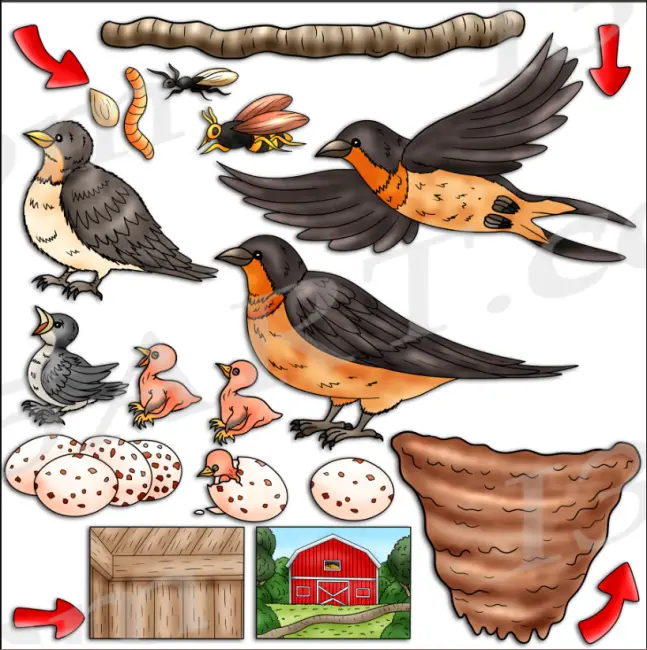
Mating Season and Nesting Behavior
Pair Formation and Courtship
The reproductive cycle of swallows begins with the onset of spring, triggered by increasing photoperiod and rising temperatures, which stimulate hormonal changes that activate breeding behavior. Males typically arrive at breeding sites several days before females, allowing them time to establish and defend territories. These territories often include prime nesting sites and nearby foraging areas—essential resources that directly influence female mate choice.
Male swallows engage in a complex array of courtship behaviors designed to display their fitness to potential mates. These displays include rapid and acrobatic flight maneuvers, vocalizations that vary in pitch and duration depending on species and individual condition, and visual cues such as the symmetry and length of tail streamers. In species like the Barn Swallow (Hirundo rustica), longer tail streamers are a reliable indicator of genetic quality and are strongly preferred by females during mate selection.
Courtship is not limited to physical displays; it also involves behavioral interactions such as aerial chases, food sharing, and mutual preening—acts that reinforce pair bonding. Once a pair is established, they typically remain socially monogamous for the breeding season, although genetic studies have shown that extra-pair copulations are relatively common in some populations. This suggests a balance between social fidelity and genetic diversity in swallow mating systems.
Choosing and Building the Nest
Nest site selection is a critical aspect of swallow reproduction, directly impacting offspring survival. Preferred sites offer structural support, protection from predators, and favorable microclimates. Common nesting locations include human-made structures like barns, culverts, and the undersides of bridges, as well as natural cliffs and rock ledges. These areas provide overhead cover and are often located near bodies of water or open fields, which support abundant insect prey.
Swallows are skilled nest architects. Barn Swallows construct open-cup nests composed of up to 1,000 individual mud pellets. These pellets are gathered by dipping their beaks into wet soil or clay and transported one at a time to the nest site. The mud framework is reinforced with organic materials such as dry grass, animal hair, and feathers, which provide structural integrity and thermal insulation. In contrast, Cliff Swallows (Petrochelidon pyrrhonota) build gourd-shaped nests with narrow tubular entrances, often in large, dense colonies that offer communal defense against predators and parasites.
Both male and female swallows actively participate in the nest-building process, which may take 1 to 2 weeks depending on weather and material availability. Once completed, the interior is lined with soft feathers to cushion the eggs and maintain stable incubation temperatures. Site fidelity is strong in many species; swallows often return to the same location—and even the same nest—each year, sometimes refurbishing old structures for reuse. This behavior conserves energy and reflects an evolutionary strategy favoring nesting success in previously successful sites.
Egg Laying and Incubation
Egg Deposition
Following successful copulation and nest completion, the female swallow enters the egg-laying phase, which is influenced by hormonal regulation, primarily estrogen and progesterone levels. Depending on the species and environmental conditions—such as temperature, food abundance, and photoperiod—she lays a clutch of approximately 3 to 7 eggs. Typically, one egg is deposited per day, often in the early morning hours.
The eggs are ovate in shape and relatively small compared to the adult bird’s body size. They are usually white or creamy in color, adorned with fine speckling in shades of brown or gray. These speckles may serve as camouflage or help with structural strengthening of the shell. The eggshells themselves are composed primarily of calcium carbonate, and the thickness may vary slightly depending on the female’s diet and health.
In regions with longer breeding seasons—especially temperate and subtropical zones—swallows may produce two broods per year, and occasionally three under ideal conditions. Multiple brooding is a strategy to maximize reproductive output, particularly in areas with high prey availability and minimal predation risk.
Incubation Period
Incubation typically begins after the final egg of the clutch is laid, a strategy that promotes synchronous hatching. This synchronization is crucial for minimizing size disparities among siblings, reducing the risk of siblicide or competitive starvation.
The incubation period generally ranges from 13 to 17 days, though this duration can be affected by ambient temperature, species differences, and maternal condition. In most swallow species, the female performs the majority of the incubation duties, while the male contributes by defending the territory and bringing food to the female during brief recesses.
A key adaptation for effective incubation is the brood patch—a specialized area on the female’s ventral surface where feathers are shed to expose a highly vascularized and heat-efficient skin. This brood patch allows for direct transfer of body heat to the developing embryos, maintaining a consistent temperature near 37.5°C (99.5°F), which is optimal for avian embryogenesis.
During incubation, the female frequently rotates the eggs to ensure uniform heat distribution and to prevent the embryo from adhering to the inner eggshell membrane. Environmental disturbances such as predation threats or prolonged cold can lead to nest abandonment or reduced hatch rates, highlighting the sensitivity of this developmental stage.
Hatching and Nestling Development
Altricial Beginnings
Swallow chicks emerge from the egg in an altricial state, meaning they are born highly underdeveloped compared to precocial birds like ducks or shorebirds. At hatching, they are blind, naked, and weigh only a few grams. Their skin is translucent and pinkish, and their skeletal and muscular systems are immature. Due to their complete dependence on parental care, the first few days post-hatching are critical for survival.
Hatching is triggered by the chick using a temporary structure called the egg tooth, located at the tip of the beak, to break through the eggshell in a process known as pipping. Once hatched, the chick emits high-frequency begging calls that stimulate feeding behavior in the adults.
Parental care begins immediately. The female typically remains in the nest for brooding, using her body heat to maintain optimal temperature for the fragile hatchlings, while both male and female swallows participate in foraging and feeding. The diet consists mainly of flying insects—flies, mosquitoes, aphids, and beetles—captured on the wing. Prey is gathered into a bolus, a compact mass of insects held in the parent’s gular pouch (throat area), and regurgitated directly into the chick’s mouth. Feeding rates can be as high as 300 to 400 deliveries per day per brood, depending on prey availability and chick age.
Rapid Growth
Swallow chicks exhibit extraordinarily rapid growth, an evolutionary adaptation to their short nesting period and exposure to predation risk. By day 4 to 6, their eyes begin to open, allowing limited visual input, and sparse natal down—fine, wispy feathers—starts to emerge. By day 10, the pin feathers (feather shafts) erupt from the skin, gradually unfurling into functional contour and flight feathers.
Alongside feather development, the chicks experience major physiological changes. Their metabolic rate increases, enabling partial thermoregulation, which reduces dependence on constant brooding. Skeletal ossification proceeds quickly, with the development of the keel (sternum) and wing bones essential for eventual flight.
Both parents remain attentive, not only feeding the young but also maintaining nest hygiene. They remove fecal sacs—encapsulated chick waste—to reduce the risk of bacterial infection or attracting predators. Parental investment remains high during this period, but brood reduction can occur naturally if food is scarce. Larger, more vigorous chicks may outcompete their smaller siblings, leading to starvation or neglect—a strategy that increases survival odds for at least part of the brood under suboptimal conditions.
By the end of the nestling period, chicks are nearly adult-sized and fully feathered, preparing for their first flight. The transition from helpless hatchling to fledgling capable of aerial life takes place in just over two weeks, a testament to the swallow’s remarkable developmental pace.
Fledging and Early Flight
Leaving the Nest
Fledging—the process by which young swallows leave the nest for the first time—typically occurs between 18 to 24 days after hatching, although the exact timing varies depending on species, environmental conditions, and food availability. The fledging period marks a major developmental milestone, transitioning the bird from a sedentary, dependent nestling to an independent, mobile juvenile.
In the days leading up to fledging, chicks undergo a preparatory phase within the nest. They engage in wing-stretching, flapping, and balancing behaviors that strengthen their flight muscles, particularly the pectorals, and improve coordination. These motor exercises are essential for building sufficient muscle tone and confidence needed for initial flight.
The first flights are often brief and clumsy, with fledglings making short glides to nearby perches such as beams, tree branches, or fences. These early attempts carry a high risk of collision or grounding, especially in windy or open areas. Despite their awkwardness, these flights are critical for neuromuscular development and air-control calibration.
Parental involvement does not cease at fledging. Adult swallows continue to feed fledglings for up to two weeks or longer, following their calls and locating them via visual and auditory cues. Parents may lead their young to prime foraging areas and issue alert calls when predators are nearby. This post-fledging dependency period is crucial for survival, as fledglings gradually acquire the skills needed to sustain themselves.
Learning to Fly and Feed
Flight proficiency and foraging competence develop rapidly during the early post-fledging stage. Fledglings must master aerial maneuverability, including banking, turning, hovering, and accelerating—all vital for capturing fast-moving prey in open skies. Unlike ground-feeding birds, swallows rely almost entirely on aerial insectivory, meaning survival depends on the ability to snatch insects mid-flight.
Young swallows begin by shadowing their parents during foraging flights, learning to identify insect swarms, optimize trajectory, and adapt wingbeats for efficiency. Through repeated trial and error, they gradually increase their prey capture success. Their eyes also develop sharper motion-tracking abilities, crucial for zeroing in on tiny, fast-flying insects like gnats or midges.
Simultaneously, fledglings develop spatial orientation and predator awareness. They learn to avoid obstacles, recognize threats such as hawks or domestic cats, and respond to alarm calls from conspecifics. This period also coincides with the strengthening of migratory muscles, particularly in long-distance migrants like Barn Swallows, which will soon embark on journeys thousands of kilometers long.
By the end of the post-fledging period, juveniles achieve full independence, no longer reliant on parental provisioning. Their flight has become fluid and sustained, and their foraging success rates have improved dramatically. At this stage, their probability of survival increases significantly, and they are ready to join flocks of other juveniles and adults as they prepare for the next phase of the life cycle: dispersal and migration.
Maturity and Migration
Reaching Adulthood
Swallows typically attain sexual maturity within their first year, meaning individuals hatched in one summer are often ready to breed by the following spring. As they approach adulthood, their physical characteristics continue to refine. Juvenile plumage gives way to the sleek, aerodynamic feathers characteristic of mature swallows, enhancing their flight efficiency. Males of certain species, such as the Barn Swallow (Hirundo rustica), also develop elongated tail streamers, which play a role in sexual selection and indicate fitness to potential mates.
Beyond physical maturity, young swallows undergo important behavioral and social transitions. They begin to participate in communal roosts, sometimes gathering in groups of hundreds or even thousands. These aggregations serve several functions: protection from predators, exchange of information about feeding sites, and social learning. Vocal communication becomes more complex and frequent during this stage, reinforcing social bonds and possibly aiding in migratory coordination.
By the time they reach full adulthood, swallows exhibit refined flight skills, allowing them to perform intricate aerial maneuvers needed for efficient foraging, courtship displays, and long-distance travel. These improvements in motor control and navigational ability are crucial for the next major life stage: migration.
The Migration Journey
Migration represents a defining and energetically demanding phase in the swallow’s annual cycle. Most species, particularly long-distance migrants like the Barn Swallow, undertake biannual migrations that span thousands of miles. For example, Barn Swallows breeding in North America travel to Central and South America, while their European counterparts journey to sub-Saharan Africa, covering distances that can exceed 6,000 miles (9,600 km) one way.
The onset of migration is governed by an intricate interplay of photoperiod (day length), hormonal shifts—particularly involving melatonin and corticosterone—and environmental cues, such as temperature changes and food availability. These physiological and external signals synchronize to trigger migratory restlessness, or zugunruhe, prompting swallows to gather in pre-migratory flocks and initiate their journey.
Young swallows often embark on their first migration with no prior experience, relying heavily on innate orientation mechanisms. These include the geomagnetic field, sun compass, star patterns, and polarized light cues. Despite their inexperience, juvenile swallows typically travel in loose flocks, which enhances survival through safety in numbers and shared navigational input.
During migration, swallows demonstrate remarkable endurance, flying for up to 300 miles (480 km) in a single day, usually during daylight hours to take advantage of rising air currents and insect activity. Stopover sites rich in insect life are critical for refueling, and wetlands, agricultural fields, and grasslands serve as essential temporary habitats along the way.
Migration is not without peril. Swallows must contend with predation, storms, exhaustion, habitat loss at stopover sites, and man-made obstacles like glass buildings and wind turbines. However, those that complete the journey arrive at their wintering grounds ready to resume feeding and social behaviors in more stable climates. Here, they remain until the return migration in spring, perpetuating the life cycle.
Lifespan and Reproductive Cycles
Longevity in the Wild
In natural conditions, swallows exhibit a moderate lifespan for small passerines, typically ranging from 4 to 8 years. However, many individuals fail to reach full maturity due to a variety of mortality risks early in life, including nest predation, food scarcity, collisions during migration, disease, and extreme weather events. First-year survival rates are particularly low, with significant attrition occurring during the initial migration and overwintering period.
Those individuals that survive into adulthood benefit from increased reproductive opportunities and experience. A successful adult swallow may produce two or more broods per breeding season, especially in warmer regions with extended summers. Over the course of their lifetime, these high-fidelity breeders can raise dozens of offspring, significantly contributing to local and migratory populations.
Breeding Site Fidelity and Reuse
A hallmark of swallow reproductive behavior is strong site fidelity. Adult swallows frequently return to the same breeding territories and even specific nest sites year after year. In species like the Barn Swallow (Hirundo rustica), pairs may rebuild or refurbish previous mud nests, conserving time and energy that would otherwise be spent on constructing new ones. This behavior not only enhances reproductive efficiency but also contributes to the stability of local breeding colonies, allowing for consistent population monitoring.
The reuse of nest sites may offer ecological advantages, such as proximity to established foraging areas, reduced exposure to predators, and familiarity with microclimate conditions. However, it also carries potential risks, including accumulated ectoparasites and structural degradation of the nest, which may necessitate repairs or abandonment.
Annual Reproductive Cycle
Each year, the reproductive cycle of swallows is tightly synchronized with seasonal changes. As spring arrives and insect prey becomes abundant, hormonal signals initiate courtship, mating, and nesting behaviors. Breeding timing is highly adaptive: early breeders may gain a competitive advantage by securing optimal nesting sites, while late-season broods take advantage of peak insect densities.
Environmental stressors—such as cold snaps, drought, or habitat disruption—can delay or limit reproductive success in a given season. Nevertheless, the capacity for multiple brooding, high parental investment, and flexible foraging strategies allows swallows to maintain robust reproductive output under variable conditions.
By maintaining strong migratory connectivity, returning to ancestral breeding and wintering grounds, and adapting to anthropogenic environments (such as nesting under human structures), swallows have demonstrated remarkable resilience. Their life history strategy—moderate longevity, high site fidelity, and multiple reproductive events per season—supports population persistence despite natural and human-imposed challenges.
Ecological Role and Environmental Sensitivity
Natural Pest Control
Swallows are highly effective aerial insectivores, performing an essential ecological function by regulating insect populations. An adult swallow can capture and consume hundreds to thousands of flying insects each day, depending on its energy needs and food availability. Their diet includes a variety of insects such as flies, mosquitoes, beetles, wasps, aphids, and even agricultural pests like locusts and leafhoppers. This insectivorous behavior not only supports the swallow’s energetic demands during breeding and migration but also benefits human agriculture and public health.
By reducing the abundance of insect vectors that transmit diseases (such as mosquitoes carrying West Nile Virus or malaria) and limiting populations of crop-damaging pests, swallows contribute to natural pest control on both local and regional scales. Their role in suppressing these insect populations is particularly important in organic farming systems, where chemical pest management is minimized or avoided. In many rural areas, swallows are considered biological allies, helping to reduce the need for pesticide application while maintaining ecological balance.
Habitat Threats and Conservation
Despite their ecological significance and adaptability, swallow populations are increasingly vulnerable to human-induced environmental pressures. One of the primary threats is habitat loss, particularly the disappearance of traditional nesting sites. Modern architecture often lacks the exposed beams, overhangs, and crevices that swallows historically used for nest attachment. In agricultural landscapes, the removal of mud sources—essential for nest construction—further compounds the problem.
Pesticide use poses a dual threat. First, it reduces the availability of insect prey, leading to food shortages during critical breeding and migratory periods. Second, swallows may ingest pesticide-contaminated insects, which can result in direct poisoning or reproductive failure. Neonicotinoids, in particular, have been linked to declines in insectivorous bird populations across multiple continents.
Climate change adds another layer of complexity. Shifts in weather patterns can lead to mismatches in food timing, where insect emergences no longer coincide with chick-rearing phases. Extreme weather events, such as cold snaps or prolonged rain during migration or breeding, can cause large-scale mortality.
Conservation strategies aim to mitigate these threats through habitat preservation, structural accommodation, and public education. Initiatives include:
-
Installing artificial nest boxes or ledges on buildings and barns
-
Protecting wetland and open field habitats used for foraging
-
Reducing or banning harmful pesticides
-
Supporting insect biodiversity through native vegetation planting
In addition, long-term monitoring programs track swallow population dynamics, migration routes, and breeding success. These data inform evidence-based conservation policies, ensuring that swallows can continue fulfilling their vital ecological role while adapting to a rapidly changing world.
Conclusion
From their delicate beginnings inside a mud-lined nest to their astonishing aerial feats, swallows undergo one of nature’s most remarkable life journeys. Their life cycle is a testament to adaptation, endurance, and ecological harmony. By understanding and protecting swallows, we not only safeguard a symbol of seasonal renewal but also preserve the balance of ecosystems they so gracefully inhabit.

